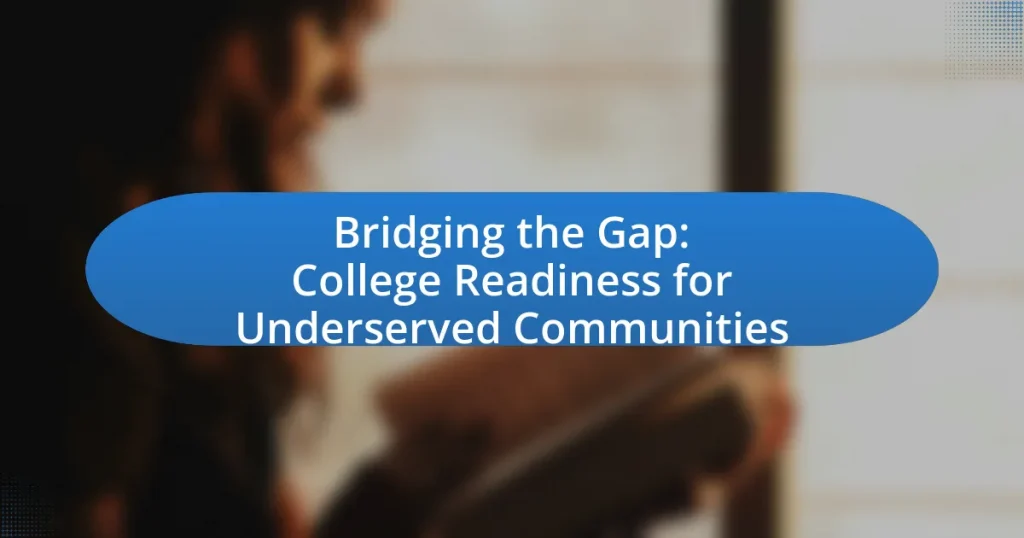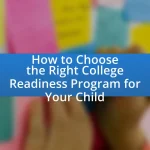The article “Bridging the Gap: College Readiness for Underserved Communities” focuses on the preparedness of students from marginalized backgrounds to transition into post-secondary education. It highlights the barriers these students face, including limited access to resources, inadequate counseling, and financial constraints, which contribute to lower college enrollment rates. Key components of college readiness discussed include academic skills, social-emotional development, and financial literacy. The article emphasizes the importance of targeted interventions, mentorship programs, and community engagement to enhance college readiness and improve long-term success for individuals from underserved communities. Additionally, it outlines strategies for schools and organizations to collaborate effectively in supporting these initiatives.
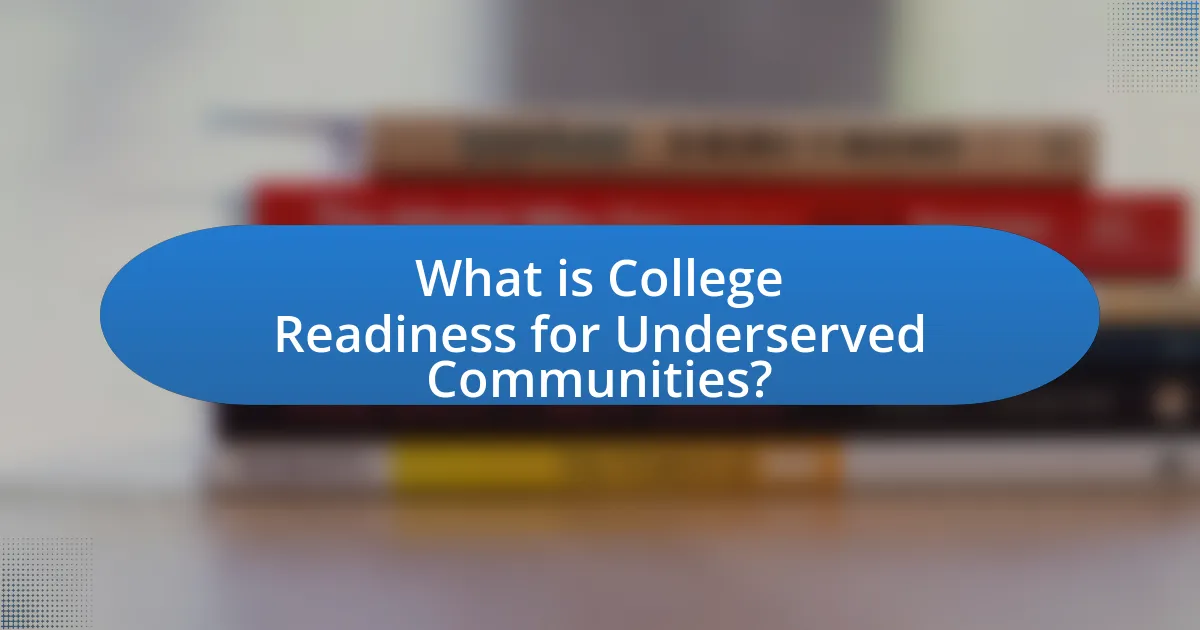
What is College Readiness for Underserved Communities?
College readiness for underserved communities refers to the preparedness of students from marginalized backgrounds to successfully transition into post-secondary education. This concept encompasses academic skills, social-emotional development, and access to resources that enable these students to navigate the college environment effectively. Research indicates that students from underserved communities often face barriers such as limited access to advanced coursework, inadequate college counseling, and financial constraints, which can hinder their readiness. For instance, a study by the National Center for Education Statistics found that only 12% of low-income high school graduates enrolled in a four-year college immediately after graduation, highlighting the disparities in college readiness among different socioeconomic groups.
Why is college readiness important for underserved communities?
College readiness is crucial for underserved communities because it directly impacts their access to higher education and subsequent economic opportunities. Research indicates that students from underserved backgrounds often face systemic barriers that hinder their academic preparation, leading to lower college enrollment rates. For instance, a report by the National Center for Education Statistics shows that only 54% of low-income high school graduates enroll in college immediately after graduation, compared to 80% of their higher-income peers. This disparity highlights the need for targeted college readiness programs that equip these students with the necessary skills and resources to succeed in higher education, ultimately fostering social mobility and reducing economic inequality.
What challenges do underserved communities face in achieving college readiness?
Underserved communities face significant challenges in achieving college readiness, primarily due to limited access to quality educational resources. These communities often experience underfunded schools, which results in inadequate facilities, outdated materials, and a lack of experienced teachers. According to the National Center for Education Statistics, schools in low-income areas receive about $1,000 less per student than those in wealthier districts, contributing to disparities in educational outcomes. Additionally, students from these communities frequently lack access to college preparatory programs, mentorship opportunities, and information about the college application process, further hindering their readiness for higher education.
How does college readiness impact long-term success for individuals from these communities?
College readiness significantly enhances long-term success for individuals from underserved communities by equipping them with the necessary skills and knowledge to thrive in higher education and beyond. Research indicates that students who are college-ready are more likely to enroll in post-secondary institutions, persist in their studies, and ultimately graduate. For instance, a study by the National Center for Education Statistics found that students who completed rigorous high school curricula were 30% more likely to earn a college degree compared to their peers who did not. This educational attainment leads to better job opportunities, higher earning potential, and improved socioeconomic status, thereby breaking cycles of poverty within these communities.
What are the key components of college readiness?
The key components of college readiness include academic preparation, social-emotional skills, and financial literacy. Academic preparation involves mastering core subjects such as math, reading, and writing, which are essential for success in college-level coursework. Social-emotional skills encompass self-regulation, resilience, and effective communication, which help students navigate the challenges of college life. Financial literacy equips students with the knowledge to manage tuition, student loans, and budgeting, ensuring they can sustain their education financially. Research indicates that students who possess these components are more likely to enroll in and complete college, highlighting their critical role in bridging the gap for underserved communities.
What academic skills are essential for college readiness?
Essential academic skills for college readiness include critical thinking, effective communication, time management, and research proficiency. Critical thinking enables students to analyze and evaluate information, which is crucial for academic success. Effective communication skills, both written and verbal, are necessary for articulating ideas clearly in assignments and discussions. Time management helps students balance coursework, deadlines, and personal responsibilities, fostering a productive academic environment. Research proficiency equips students with the ability to locate, evaluate, and synthesize information from various sources, a skill vital for completing college-level assignments. These skills collectively prepare students for the demands of higher education, as supported by studies indicating that students who possess these competencies are more likely to succeed in college.
How do social and emotional skills contribute to college readiness?
Social and emotional skills significantly enhance college readiness by fostering resilience, effective communication, and interpersonal relationships. These skills enable students to manage stress, collaborate with peers, and navigate the complexities of college life. Research indicates that students with strong social and emotional competencies are more likely to achieve academic success and persist in their studies. For instance, a study by the Collaborative for Academic, Social, and Emotional Learning (CASEL) found that social-emotional learning programs can lead to an 11 percentile-point gain in academic achievement. This evidence underscores the critical role that social and emotional skills play in preparing students for the challenges of higher education.
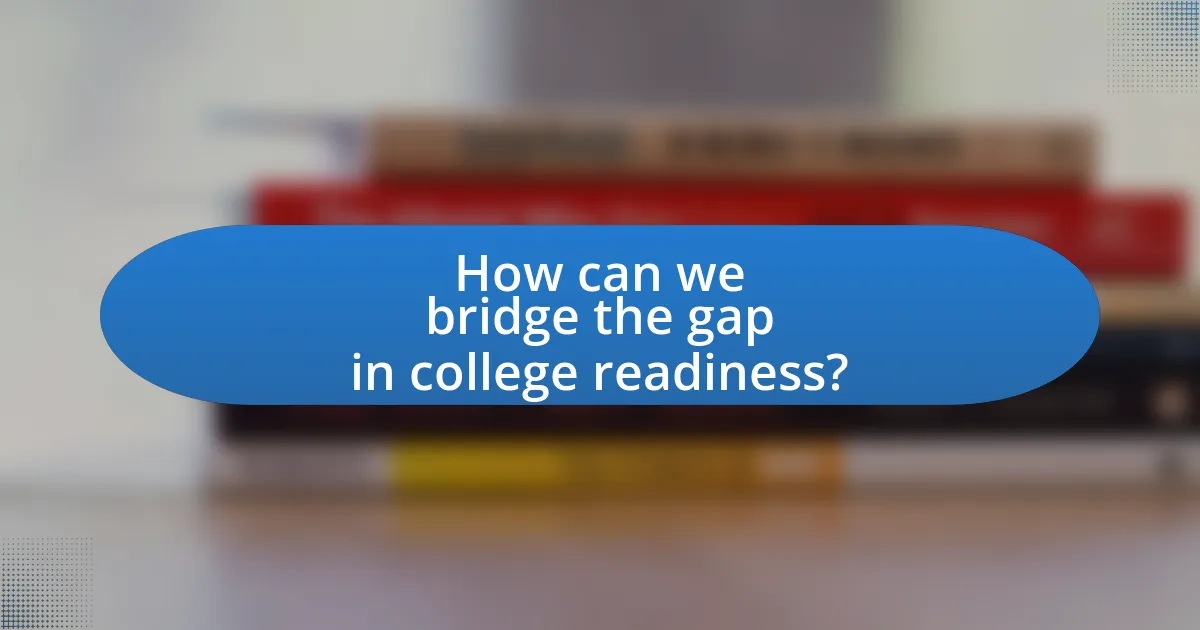
How can we bridge the gap in college readiness?
To bridge the gap in college readiness, targeted interventions must be implemented that focus on academic support, mentorship, and access to resources. Research indicates that underserved communities often lack access to advanced coursework and college preparatory programs, which can hinder students’ preparedness for higher education. For instance, a study by the National Center for Education Statistics found that students from low-income backgrounds are less likely to take Advanced Placement courses, which are critical for college readiness. By providing tutoring, mentorship programs, and workshops that focus on college application processes, schools can enhance students’ skills and confidence. Additionally, partnerships with local colleges can facilitate dual enrollment opportunities, allowing high school students to earn college credits while still in school, further bridging the readiness gap.
What strategies can be implemented to improve college readiness in underserved communities?
To improve college readiness in underserved communities, implementing comprehensive mentorship programs is essential. These programs connect students with mentors who provide guidance on academic and career pathways, fostering a supportive environment that encourages higher education aspirations. Research indicates that students with mentors are 55% more likely to enroll in college and 78% more likely to volunteer regularly, demonstrating the positive impact of mentorship on educational outcomes. Additionally, integrating college preparatory curricula in high schools, along with access to resources such as SAT/ACT preparation and college application workshops, can significantly enhance students’ readiness. Studies show that targeted interventions, such as those provided by organizations like College Possible, have successfully increased college enrollment rates among low-income students by up to 20%.
How can schools collaborate with community organizations to enhance support?
Schools can collaborate with community organizations to enhance support by establishing partnerships that provide resources, mentorship, and programs tailored to student needs. For instance, schools can work with local nonprofits to create after-school tutoring programs, which have been shown to improve academic performance among underserved students. Research indicates that students participating in such programs are 30% more likely to achieve grade-level proficiency compared to their peers who do not receive additional support. Additionally, schools can engage community organizations to facilitate workshops on college readiness, financial literacy, and career exploration, thereby equipping students with essential skills and knowledge for post-secondary success.
What role do families play in fostering college readiness?
Families play a crucial role in fostering college readiness by providing emotional support, academic encouragement, and resources necessary for higher education. Research indicates that parental involvement significantly influences a child’s educational aspirations and achievements; for instance, a study by the National Center for Education Statistics found that students with engaged parents are more likely to enroll in college. Additionally, families can facilitate access to information about college options, financial aid, and application processes, which are essential for underserved communities where such knowledge may be limited. This support system not only enhances students’ confidence but also equips them with the skills and motivation needed to succeed in a college environment.
What resources are available to support college readiness initiatives?
Resources available to support college readiness initiatives include academic support programs, mentorship opportunities, financial aid resources, and community partnerships. Academic support programs, such as tutoring and college preparatory courses, help students improve their skills and knowledge necessary for college success. Mentorship opportunities connect students with experienced individuals who provide guidance and encouragement throughout the college application process. Financial aid resources, including scholarships and grants, assist students in overcoming financial barriers to higher education. Community partnerships, often involving local organizations and schools, create collaborative efforts to enhance access to college readiness resources. These initiatives have been shown to increase college enrollment rates among underserved populations, as evidenced by studies indicating that targeted support can significantly improve educational outcomes.
How can technology be leveraged to improve access to college readiness programs?
Technology can be leveraged to improve access to college readiness programs by providing online platforms that offer resources, courses, and personalized learning experiences. These platforms can reach underserved communities, where traditional access to such programs may be limited. For instance, online tutoring services and virtual classrooms enable students to engage with college readiness materials from anywhere, breaking geographical barriers. According to a report by the National Center for Education Statistics, online learning has increased access to educational resources, with 77% of public colleges offering online courses as of 2020. This shift allows students to learn at their own pace and access a wider range of materials, ultimately enhancing their preparedness for college.
What funding opportunities exist for programs aimed at underserved communities?
Funding opportunities for programs aimed at underserved communities include federal grants, state funding, private foundations, and corporate sponsorships. For instance, the U.S. Department of Education offers grants such as the Title I program, which allocates funds specifically to schools serving low-income students, thereby enhancing educational resources. Additionally, organizations like the Ford Foundation and the Gates Foundation provide substantial financial support for initiatives that promote equity in education. According to the National Center for Education Statistics, targeted funding can significantly improve college readiness among underserved populations, demonstrating the effectiveness of these financial resources in bridging educational gaps.
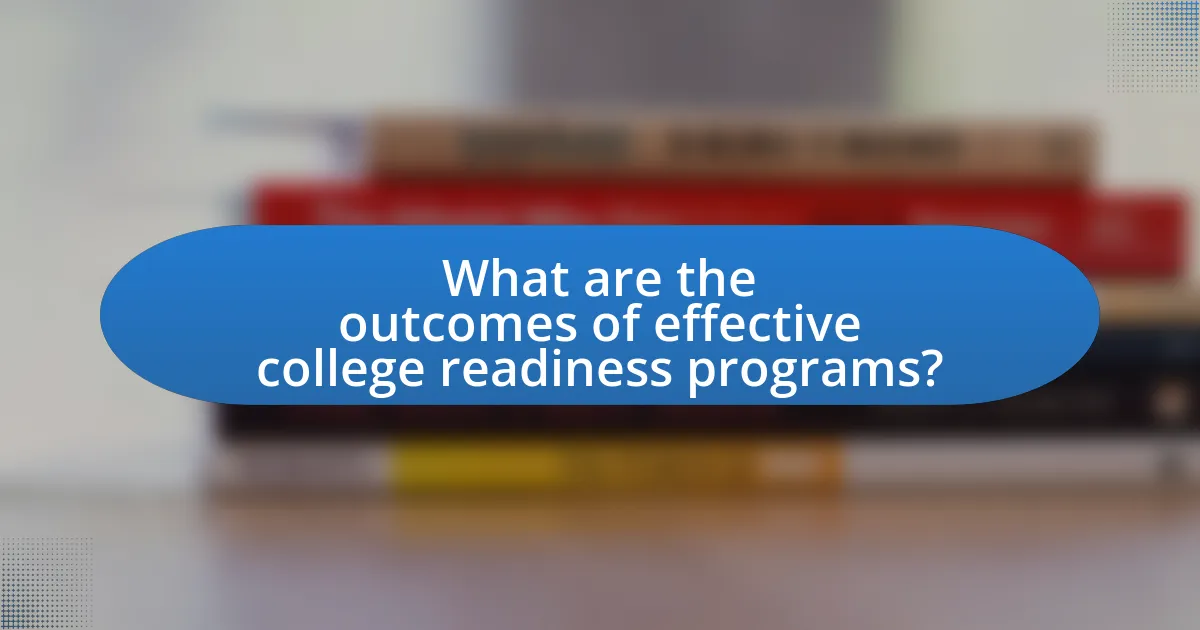
What are the outcomes of effective college readiness programs?
Effective college readiness programs lead to increased college enrollment rates, improved academic performance, and higher graduation rates among students. These programs equip students with essential skills, such as critical thinking and time management, which are crucial for success in higher education. Research indicates that students who participate in comprehensive college readiness initiatives are 20% more likely to enroll in college compared to their peers who do not participate. Additionally, these programs often provide support systems, such as mentoring and tutoring, which further enhance students’ preparedness and confidence, ultimately contributing to a more equitable educational landscape for underserved communities.
How do successful college readiness programs measure their impact?
Successful college readiness programs measure their impact through a combination of quantitative and qualitative metrics, including student enrollment rates in post-secondary education, retention rates, and academic performance indicators. For instance, programs often track the percentage of participants who enroll in college immediately after high school, which provides a clear metric of success. Additionally, they may assess improvements in standardized test scores, GPA, and completion of college preparatory courses. Research indicates that programs like the College Possible initiative have shown that participants are 2.5 times more likely to enroll in college compared to their peers, demonstrating the effectiveness of structured support and resources. Furthermore, qualitative assessments, such as surveys and interviews with students, provide insights into personal growth, confidence levels, and preparedness for college challenges, reinforcing the overall impact of these programs.
What success stories exist from underserved communities that have improved college readiness?
Success stories from underserved communities that have improved college readiness include the “I Have a Dream” Foundation, which has provided mentorship and financial support to thousands of students, resulting in a 90% high school graduation rate among participants. Additionally, the College Bound program in Washington, D.C., has successfully increased college enrollment rates among low-income students by offering academic support and college counseling, leading to a 70% college attendance rate for its graduates. These programs demonstrate effective strategies in enhancing college readiness through targeted support and resources.
How can data be used to refine and enhance college readiness initiatives?
Data can be used to refine and enhance college readiness initiatives by identifying gaps in student preparedness and tailoring interventions accordingly. For instance, analyzing standardized test scores and course completion rates can reveal specific areas where students struggle, allowing educators to implement targeted support programs. Research from the National Center for Education Statistics indicates that students from underserved communities often face unique challenges, such as lower access to advanced coursework, which can be addressed through data-driven strategies. By continuously monitoring student progress and outcomes, institutions can adjust their initiatives to better meet the needs of these populations, ultimately improving college readiness and success rates.
What best practices can be adopted for future college readiness efforts?
To enhance college readiness efforts for underserved communities, implementing comprehensive support systems is essential. These systems should include mentorship programs that connect students with college-educated professionals, providing guidance and encouragement. Research indicates that mentorship significantly improves students’ academic performance and college aspirations, as evidenced by a study from the National Mentoring Partnership, which found that mentored youth are 55% more likely to enroll in college. Additionally, integrating college preparatory curricula in high schools can equip students with necessary skills and knowledge, as shown by the College Board’s findings that students who take Advanced Placement courses are more likely to succeed in college. Furthermore, fostering partnerships between schools and local colleges can create pathways for dual enrollment, allowing students to earn college credits while still in high school, thereby increasing their readiness and confidence.
How can continuous feedback improve college readiness programs?
Continuous feedback can significantly enhance college readiness programs by providing real-time insights into student performance and areas needing improvement. This ongoing communication allows educators to tailor instruction and support to meet individual student needs, thereby increasing engagement and retention. Research indicates that programs incorporating continuous feedback mechanisms, such as formative assessments and regular check-ins, lead to higher academic achievement and better preparation for college-level work. For instance, a study by Hattie and Timperley (2007) found that feedback is one of the most powerful influences on learning, with an effect size of 0.79, indicating substantial benefits when effectively implemented in educational settings.
What role does community engagement play in sustaining college readiness initiatives?
Community engagement is essential for sustaining college readiness initiatives as it fosters collaboration between educational institutions, families, and local organizations. This collaboration enhances resource sharing, increases awareness of college readiness programs, and builds a supportive network that encourages student participation. Research indicates that initiatives involving community stakeholders see higher student engagement and improved academic outcomes, as evidenced by a study from the National Center for Education Statistics, which found that schools with strong community ties reported a 20% increase in college enrollment rates among underserved students.
What practical steps can individuals take to support college readiness in their communities?
Individuals can support college readiness in their communities by volunteering as mentors or tutors for students. This direct engagement helps students improve their academic skills and gain confidence in their abilities. Research indicates that mentorship programs can significantly enhance students’ college aspirations and readiness; for example, a study by the National Mentoring Partnership found that mentored youth are 55% more likely to enroll in college. Additionally, individuals can organize workshops that focus on college application processes, financial aid, and scholarship opportunities, which are crucial for underserved communities. By providing resources and information, individuals can empower students to navigate the complexities of higher education successfully.
